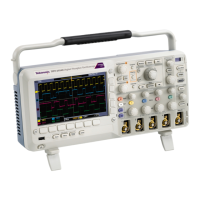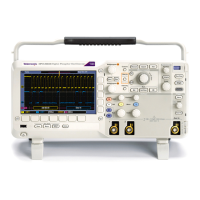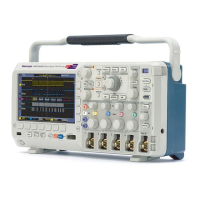Status and Events
many commands t
o the input buffer. The controller is still tied up though, and
the repeated BUSY? query will result in bus traffic.
Using the *OPC Command
If the corresponding status registers are enabled, the *OPC command sets the
OPC bit in the
Standard Event Status Register (SESR) when an operation is
complete. You achieve synchronization by using this command with either a
serial poll or service request handler.
Serial Poll Method: Enable the OPC bit in the Device Event Status Enable
Register (DESER) and the Event Status Enable Register (ESER) using the DESE
and *ESE commands.
When the operation is complete, the OPC bit in the Standard Event Status Register
(SESR) will be enabled and the Event Status Bit (ESB) in the Status Byte Register
will be enabled.
The same command sequence using the *OPC command for synchronization with
serial polling looks like this:
/* Set up conditional ac quisition */
ACQUIRE:STATE OFF
SELECT:CH1 ON
ACQUI
RE:MODE SAMPLE
ACQUIRE:STOPAFTER SEQUENCE
/* Enab le the s tatus registers */
DESE 1
*ESE 1
*SRE 0
/* A
cquire w aveform data */
ACQUIRE:STATE ON
/* Set up the measurement parameters */
MEASUREMENT:IMMED:TYPE AMPLITUDE
MEASUREMENT:IMMED:SOURCE CH1
/* Wait until the acquis ition is complete before taking the
measurement.*/
*OPC
While s erial poll = 0, keep loopi ng
/* Take amplitude measurement */
MEASUREMENT:IMMED:VALUE?
This technique requires less bus trafficthandidloopingonBUSY.
Service Request Method: Enable the OPC bit in the Device Event Status Enable
Register (DESER) and the Event Status Enable Register (ESER) using the DESE
and *ESE commands.
You can also enable service requests by setting the ESB bit in the Service Request
Enable Register (SRER) using the *SRE command. When the operation is
complete, the oscilloscope will generate a Service Request.
3-10 MSO2000B, DPO2000B, MSO2000 and DPO2000 Series Oscilloscopes Programmer Manual

